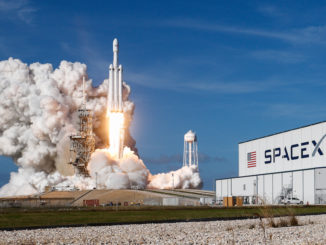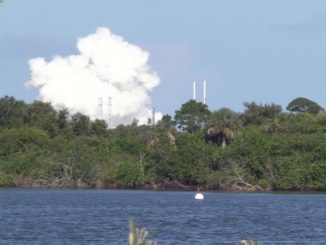Updated to add spacecraft status and orbit information.
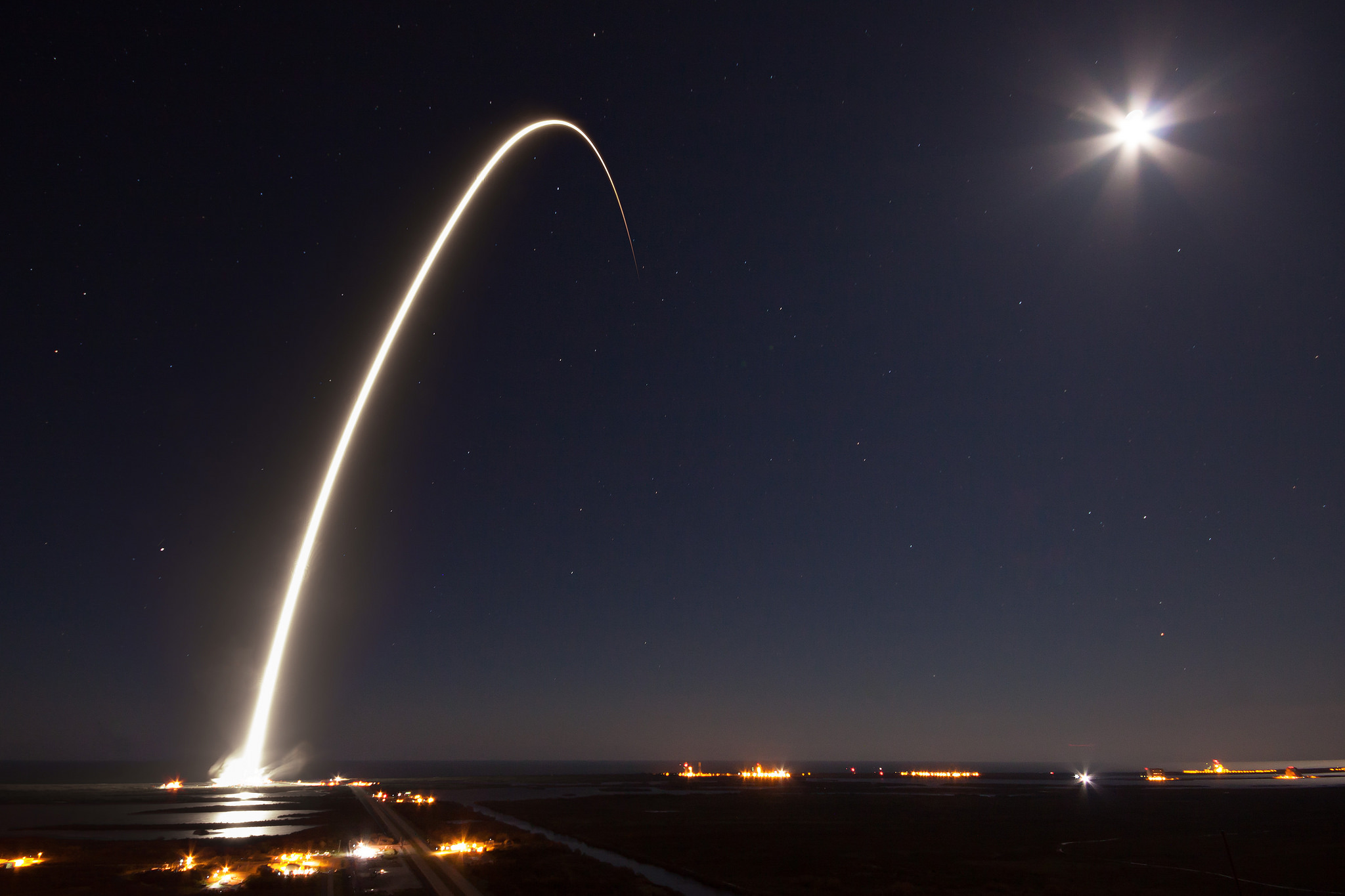
A SpaceX Falcon 9 rocket launched into a starry moonlit sky Thursday from NASA’s Kennedy Space Center in Florida, making a speedy trek across the Atlantic Ocean to place a commercial television broadcast satellite into orbit for EchoStar.
The nearly 23-story rocket, powered by nine Merlin 1D engines, ignited and blasted off from historic launch pad 39A at the Kennedy Space Center at 2 a.m. EDT (0600 GMT), turned east and rumbled skyward on top of 1.7 million pounds of thrust.
The fiery orange takeoff was pushed back 25 minutes Thursday out of concern for unfavorable high-altitude winds. High winds also scrubbed a launch attempt Tuesday.
A rush of window-rattling sound reached spectators a few miles away from the launch pad moments after liftoff, as the rocket climbed into the stratosphere trailing a flickering flame of exhaust from its main engines.
The rocket passed the speed of sound just after the one-minute mark, and weathered the mission’s most crushing aerodynamic forces moments later as SpaceX engineers called out reports on the status of the flight, its altitude, velocity and distance downrange from the launch pad.
The first stage cut off and separated less than three minutes after liftoff to fall into the Atlantic. Thursday’s flight was the first time SpaceX has not attempted to recover a Falcon 9 booster stage since April 2015.
The commercial EchoStar 23 satellite mounted atop the Falcon 9 rocket weighed around 12,345 pounds (5,600 kilograms) at launch, according to its California-based manufacturer, Space Systems/Loral. The heavy weight of the spacecraft required all of the Falcon 9’s lift capability, leaving no propellant left over to attempt a propulsive vertical landing on a barge at sea.
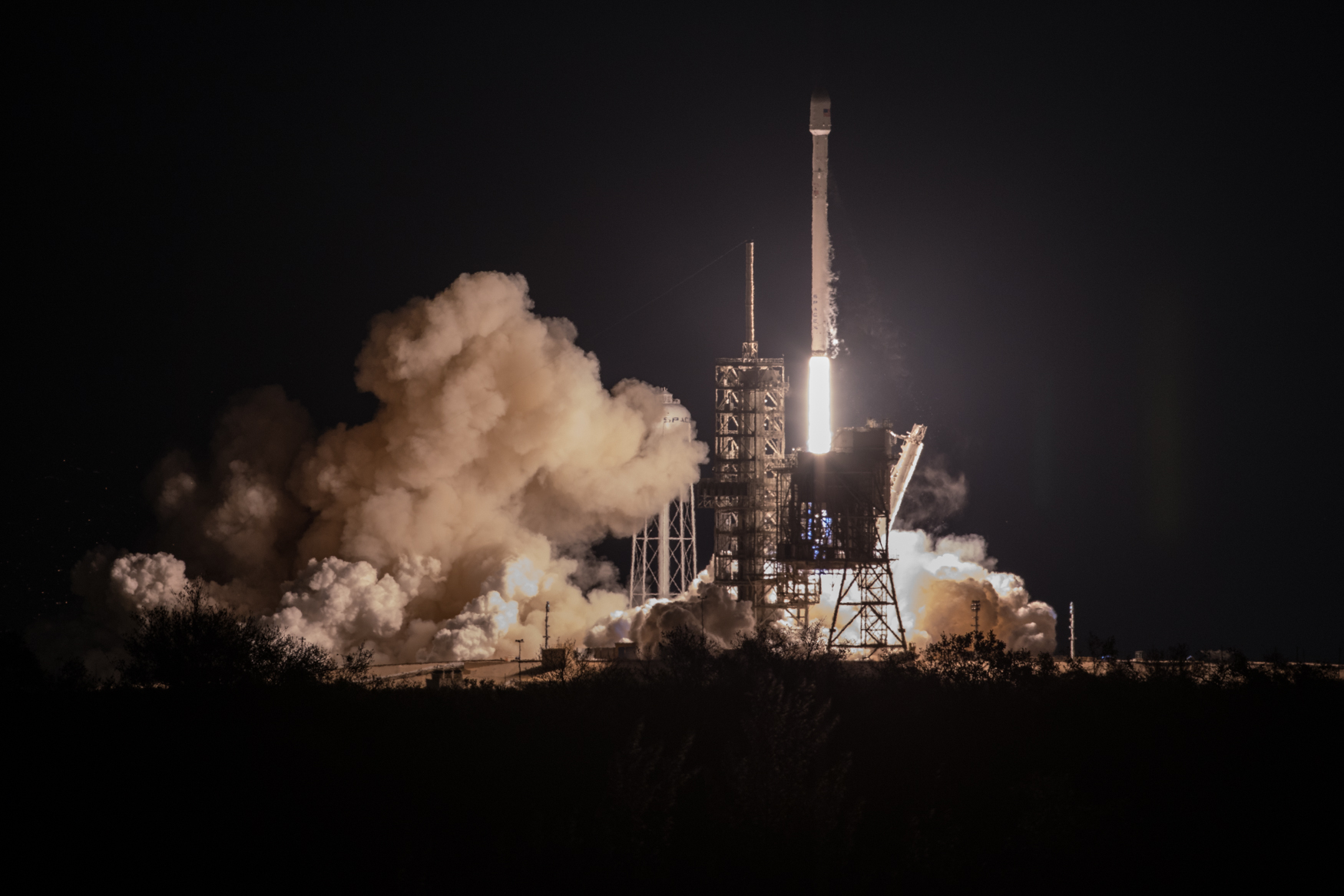
The upper stage’s single Merlin engine ignited as programmed, its nozzle glowing red-hot in live video from an on-board camera as the rocket disappeared from view in Florida.
After switching off around eight-and-a-half minutes into the mission, the second stage engine reignited as the rocket crossed the equator to boost the EchoStar 23 satellite into a high-altitude transfer orbit ranging at least 20,000 miles into space.
A forward-facing camera showed EchoStar 23 flying free of the rocket, deploying on schedule at T+plus 34 minutes.
According to U.S. military satellite tracking data, EchoStar 23 was placed in an orbit ranging between 111 miles (179 kilometers) and 22,309 miles (35,903 kilometers) in altitude, with a tilt of about 22.4 degrees to the equator. SpaceX and EchoStar officials did not disclose the altitude or inclination targeted by the Falcon 9’s flight computers.
Officials celebrated the smooth ascent, punctuating the third Falcon 9 launch of 2017 and the 31st Falcon 9 flight overall.
Space Systems/Loral confirmed EchoStar 23 deployed its solar panels as planned after Thursday’s launch.
“This is the third satellite built for EchoStar by SSL to be placed on orbit since last June,” said John Celli, president of SSL. “I would like to thank EchoStar, SpaceX and our own engineers and technicians who all worked as a team to make this launch a success.”
EchoStar 23 will fire its own engine several times over several days, beginning Friday night, to circularize its orbit at an altitude of around 22,236 miles (35,786 kilometers) and zero out its inclination over the equator. The craft will unfurl its antennas and power-generating solar panels, go through a commissioning and test period, and enter service in a couple of months.
Ultra-efficient plasma thrusters will keep the satellite’s orbit maintained over its 15-year lifetime. EchoStar 23’s first mission will be to broadcast direct-to-home television signals to Brazilian customers with a Ku-band communications payload from a position in geostationary orbit at 45 degrees west longitude.
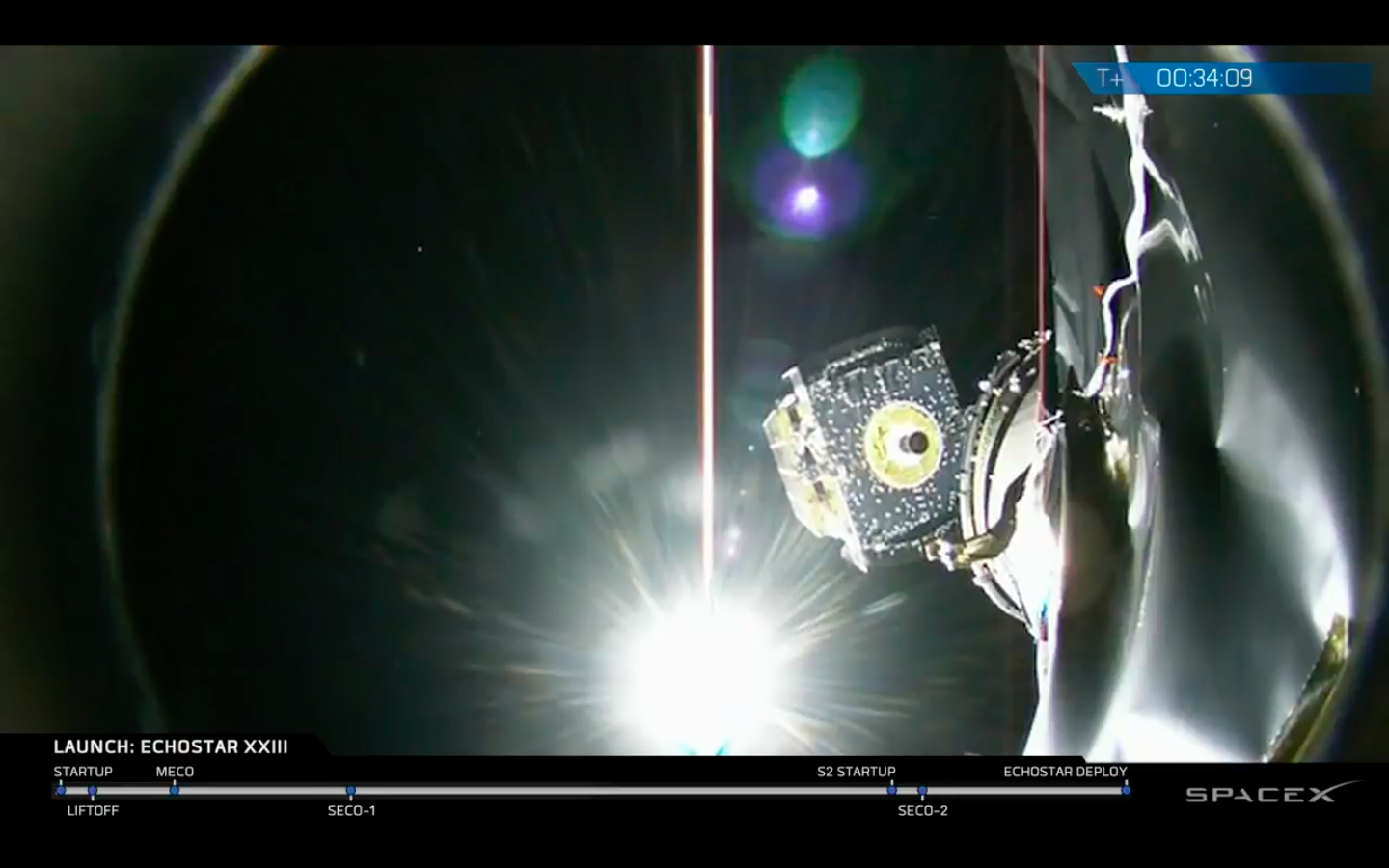
Based on the SSL 1300 satellite bus, EchoStar 23 was ordered by Colorado-based EchoStar Satellite Services in 2014 and is based on the spacecraft chassis originally built for the CMBStar mobile communications station, a venture into the Chinese market led by EchoStar and canceled in 2008.
The tri-band EchoStar 23 satellite is designed with flexibility, according to EchoStar, with the ability to carry out multiple types of missions. Its communications payload includes Ku-band, Ka-band and S-band transponders.
The craft was originally supposed to launch by the end of 2016, in time to meet a licensing deadline from ANATEL, the Brazilian communications regulatory agency, that requires EchoStar 23 be in service by the end of June.
EchoStar says it will meet that deadline for the Ku-band spectrum, which the company intends to use for television broadcast services in Brazil. The operator has sought an extension on the Ka-band and S-band deadlines, EchoStar said in its annual report released Feb. 24.
The company said is still exploring options to use its Ka-band and S-band spectrum rights by the regulatory deadline in mid-2017.
Rippling delays in SpaceX’s launch manifest caused the slip in EchoStar 23’s liftoff after a Falcon 9 rocket exploded Sept. 1 on a launch pad at Cape Canaveral, grounding SpaceX missions more than four months.
Thursday’s launch also marked a turning point for the U.S. Air Force’s Eastern Range, which manages tracking and safety facilities at Cape Canaveral. It was the final Falcon 9 flight with a manually-commanded destruct system, in which an Air Force safety officer would destroy an errant rocket if something went wrong after liftoff.
“All future SpaceX rockets will utilize an Autonomous Flight Safety System which replaces the ground-based mission flight control personnel and equipment with on-board positioning, navigation and timing sources and decision logic,” the Air Force said in a statement.
The autonomous mechanism has flown numerous times in test mode, and it flew as the primary safety system for the first time on any vehicle on a Falcon 9 launch Feb. 19.
“The benefits of AFSS include increased public safety, reduced reliance on range infrastructure, reduced range spacelift cost, increased schedule predictability and availability, operational flexibility, and launch slot flexibility,” the Air Force said.
The successful Falcon 9 launch Thursday clears the way for two flights by United Launch Alliance at Cape Canaveral in the next week.
A Delta 4 rocket is scheduled to launch Saturday with the U.S. Air Force’s WGS 9 communications satellite built with funding from military partners in Canada, Denmark, the Netherlands, Luxembourg and New Zealand.
An Atlas 5 launcher is set for liftoff March 23 or 24 with a NASA-contracted, commercially-owned Orbital ATK Cygnus cargo carrier with supplies and experiments to the International Space Station.
SpaceX says it will launch missions at a tempo of one every two to three weeks this year. The space transportation company, founded and led by Elon Musk, has a hefty backlog of launches in its order book, including a $2.6 billion contract with NASA to develop and fly commercial spaceships with astronauts between Earth and the International Space Station.
An unpiloted version of the Dragon crew capsule could fly before the end of the year, and two astronauts are slated to launch on a Dragon spacecraft next year on a test flight.
Other milestone missions coming up for SpaceX include the maiden launch of the Falcon Heavy, a powerful triple-body booster capable of delivering two to three times the payload mass to space as the Falcon 9. The long-awaited inaugural flight, originally set for 2013, is now expected this fall.
But first, SpaceX plans a launch later this month with a previously-flown Falcon 9 first stage, a significant step toward the company’s objective of reusing rocket parts with minimal refurbishment, an achievement Musk says will drive down the cost of space launches.
The reused booster, with a newly-built second stage and payload shroud on top, will send the SES 10 communications satellite into orbit for SES of Luxembourg.
Before the two-day slip in EchoStar 23’s launch, the SES 10 mission on track for liftoff March 27. Officials plan to re-assess the launch date after SpaceX completes inspections of the launch pad following Thursday’s takeoff.
Email the author.
Follow Stephen Clark on Twitter: @StephenClark1.

